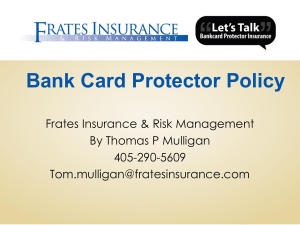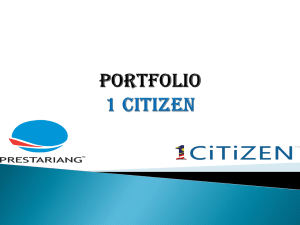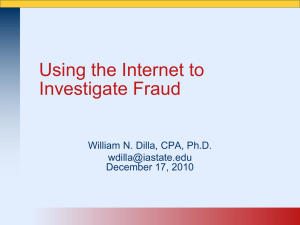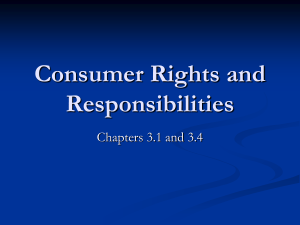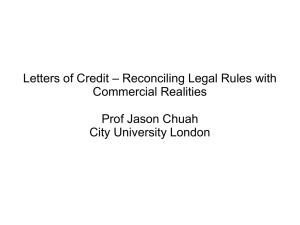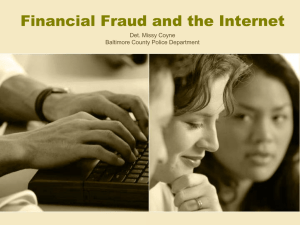fraud
advertisement
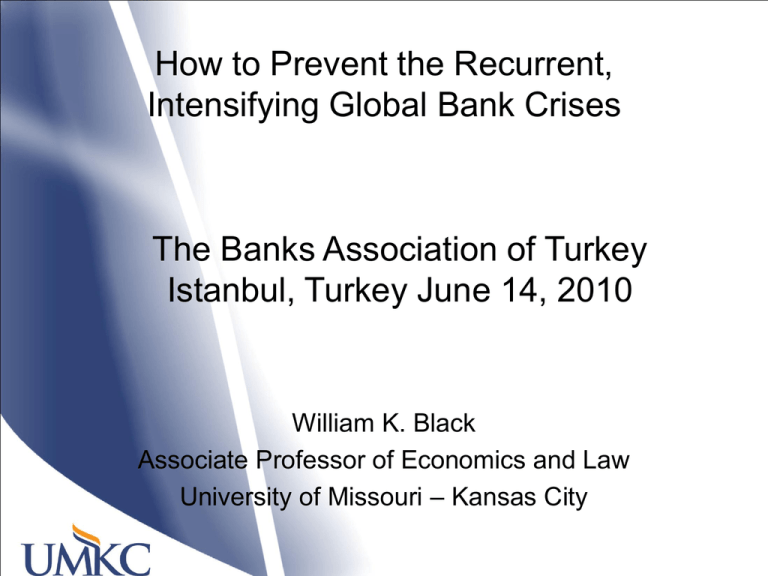
How to Prevent the Recurrent, Intensifying Global Bank Crises The Banks Association of Turkey Istanbul, Turkey June 14, 2010 William K. Black Associate Professor of Economics and Law University of Missouri – Kansas City Discussing What We Got Wrong Won’t try to tell you about Turkey Emphasis is on our mistakes, in the hopes you can avoid them Will also look briefly at some other nations I’ve studied You decide, and we can discuss, whether our errors are relevant to Turkey Caution: No Crisis in Turkey? 1. Crime displacement v. reduction: other nations were more “criminogenic” 2. The global crisis is not over: The EU/ECB/Euro quagmire; “periphery”, & U.S. accounting gimmicks 3. China: the mother of all bubbles 4. Currency speculators could target you 5. “Can’t happen here”: Japan confident Fraud is a “Sure Thing” “Control fraud” is a “sure thing” Finance: accounting = “weapon of choice” Fraudulent lenders’ optimization recipe: 1. Grow massively 2. Make really bad loans with higher yield 3. Extreme leverage 4. Trivial loan loss reserves (ALLL) Direct insider looting shows no fear of law Recipe for Catastrophe The same recipe maximizes (fake) record profits and (real) catastrophic loss “Criminogenic environments” lead to fraud epidemics & hyper-inflated bubbles “Echo” epidemics: fraud epidemics are criminogenic – cause/permit epidemics Deceit erodes trust: markets can fail What is Control Fraud? Criminology: The persons controlling a seemingly legitimate entity use it as a “weapon” to defraud. The Best Way to Rob a Bank is to Own One (Black 2005) Economics (Akerlof & Romer 1993): “Looting: Bankruptcy for Profit” Superb theoretical & empirical support by top scholars & regulators – ignored Past Turkish Crises Fraud and Banking Crises: Evidence from Micro-level Transactions Data • H. Bartu Soral, Talan B. İşcan, and Gregory Hebb: Dalhousie University • December 1, 2003 Related lending & “back-to-back” loans Esbank: self-funded “capital”: authors find Akerlof & Romer style “looting” Lessons Learned? The Turkish Banking Sector: Challenges & Outlook in Transition to EU Membership Alfred Steinherr, Ali Tukel and Murat Ucer BEEP briefing n°9: December 2004 Recurrent Turkish banking crises 1999-2000 one of the most severe in world But sees great regulatory improvement: hopes are EU accession & Basel II Such Frauds Can Maim & Kill Chinese infant formula New York inspector: asbestos & lead Turkish building inspectors: seismic risk Fake anti-malarial drugs Unlawful disposal of toxic waste Blood diamonds Deforestation: fake certificates “Gresham’s Dynamic” George Akerlof’s 1970 “lemons” article (Nobel Prize, Economics, 2001) When cheaters gain a competitive advantage: drive honest from market Markets become intensely perverse Erosion of ethics will spread Particularly if done by elites Makes reputation perverse Three Recent U.S. Crises Each was the largest financial scandal in history – until it was quickly surpassed Each driven by a control fraud epidemic 1. S&L debacle of the 1980s ($150 B) 2. Enron, WorldCom (>$1 T) 3. Nonprime (multi-trillion) Failure to learn lessons due to “theoclassical” economic myths Fraud in the S&L Debacle “The typical large failure [grew] at an extremely rapid rate, achieving high concentrations of assets in risky ventures…. [E]very accounting trick available was used…. Evidence of fraud was invariably present as was the ability of the operators to “milk” the organization” (NCFIRRE 1993) Finding the Facts: “Autopsies” We reviewed every failure NTSB reviews every plane crash Didn’t rely on false accounting Optimization led to patterns: analytics Knew econometrics were perverse Understanding fraud schemes essential Our findings enraged industry, politicians and many regulators Enron era Frauds All accounting control frauds Over $6 trillion loss of market capitalization Led to Sarbanes-Oxley law (no input from criminologists, doesn’t address problem) Helped lead to Greenspan supporting particularly expansive monetary supply Current U.S. Crisis Ignores Fraud Despite prior control fraud epidemics Absurd framing: “perfect storm” FBI (2004) “epidemic” of mortgage fraud Predicted a crisis if fraud increased Anti-regulators triumph No criminal referrals No convictions, indictments, arrests Mission Accomplished Real Regulation Can Work Used “markers” to identify control frauds Regulators recognized control frauds were the key: served as “Sherpa” 1000 FBI agents & top agency priority >1000 priority felony convictions Greatest success v. elite criminals Prevented nonprime crisis: 1990-91 Where We Look, We Find WaMu Citicorp Lehman Goldman Rating agencies Fannie & Freddie The most elite institutions in the world Iceland Looked, Found Fraud SIC found the Big 3 followed the recipe for optimizing accounting fraud 1. Exceptional growth: 50% 2. Bad loans with high yields 3. Essentially infinite leverage 4. Loss reserves were a sick joke Sure thing: record “profits” & losses But SIC Calls it Bad Luck “The situation in the international financial markets in the autumn of 2008 has been described as the perfect storm. It was under this situation that the three Icelandic banks, Glitnir, Landsbanki and Kaupthing Bank, collapsed at the beginning of October 2008.” Gambling Metaphor As the winter of 2007-2008 progressed, the banks were very dependent of their share prices and largest debtors. Rather than hanging on to their liquid assets, the banks provided substantial amounts as loans for own shares and to support their principal owners. Kaupthing Bank in particular loaned large amounts for the purchase of own shares. The banks were betting everything on life. Bad Luck Mark Flannery’s “Post-Mortem” (p. 91): “Any firm’s failure reflects some combination of bad luck and bank management.” No: Not underwriting = adverse selection Creates negative expected value Fake profits and real losses are certain Bad Loans are Best “Accounting abuses also provided the ultimate perverse incentive: it paid to seek out bad loans because only those who had no intention of repaying would be willing to offer the high loan fees and interest required for the best looting. It was rational for operators to drive their institutions ever deeper into insolvency as they looted them.” (Pierce 1994) Gresham’s & the Auditors “[A]busive operators of S&L[s] sought out compliant and cooperative accountants. The result was a sort of "Gresham's Law" in which the bad professionals forced out the good.” (NCFIRRE 1993) Control frauds are criminogenic; they can cause “echo” epidemics by creating these perverse incentives Accounting Cover Ups The Icelandic scams are old scams “Dirt for stock”: self-funded (fictional – not “weak” capital) Self-funded loans Refinancing: “A rolling loan gathers no loss” Guaranteed “profit” w/o losses Ireland Anglo Irish Bank Scandal Self-funded “capital” Loans to Insiders & Cronies Regulatory capture Massive bubble Secret, then public, bailouts Spain Originally touted as success story Claim based on “dynamic provisioning” But the loss reserves were perhaps onefifth as large as appropriate Nest of insider loans, Cajas the worst? Massive property bubble Not recognizing losses; markets frozen Fraud Epidemics & Bubbles Perverse incentives are the key The most criminogenic environment loses Particularly if entry is easy: regulation Some assets are superior “ammunition” for accounting fraud: “liar’s loans” Causes frauds to cluster: industry/assets Recipe causes bubbles to hyper-inflate Echo Epidemics Nonprime lenders: primary epidemic Create criminogenic environments Upstream: buy anything; pay for yield Must gut underwriting & suborn controls Necessary & sufficient to cause upstream Necessary, but not sufficient, to cause downstream epidemic of CDOs & CDS Adverse Selection Crises began when the loans were made Not underwriting causes adverse selection That causes negative expected value It necessitates accounting fraud: ALLL Honest accounting would show the loans were losses when they were made The firm fails; the fraud scheme succeeds Perfect Storms & Black Swans Both assume risk is exogenous We spawn the black swans & storms through our perverse market incentives Control fraud creates risk, but “risk” is the wrong lens: record (fictional) profits and (real) catastrophic losses are certain for looting control frauds; the only issues are timing and the magnitude of the loss Provide Fraud “Markers” Metaphor from pathology: fraud “markers” No honest secured lender would routinely: • Inflate appraisal values • Knowingly permit inflated appraisals • Create severe adverse selection • Create a Gresham’s dynamic • Reduce ALLL while increasing risk Regulation = easy to prosecute cover ups Lying Becomes Endemic Upstream: appraisers, loan brokers Primary: loan officers, auditors Downstream: rating agencies, poolers Financial version of “don’t ask; don’t tell” Lying about big things: farblondget Fire the honest; promote the worst Gresham’s dynamic only needs a minority Markets Fail Rather than Clear Fraud: create, then betray, trust Fraud is worst “acid” for eroding trust Trust often vital, e.g., in markets Gresham’s can make fraud endemic What if one bottle in 100 is contaminated? Markets can fail rather than clear Nonprime secondary market Private Market Discipline Control frauds falsify modern finance Therefore, they must not exist • “a rule against fraud is not an essential or … an important ingredient of securities markets” (Easterbrook & Fischel 1991) • Greenspan: no need to regulate v. fraud • Patrick Parkinson: no derivatives fraud Naïve Oxymoron Control frauds turn sources of “private market discipline” into fraud allies They fund the frauds’ growth They’re vectors spreading fraud epidemics Caused downstream CDO/CDS epidemic Don’t ask; don’t tell – so you can sell Subordinated debt: failed utterly “Don’t Ask; Don’t Tell” Any request for loan level tapes is TOTALLY UNREASONABLE!!! Most investors don't have it and can't provide it. [W]e MUST produce a credit estimate. It is your responsibility to provide those credit estimates and your responsibility to devise some method for doing so. [S&P ’01, emphasis in the original.] Criminogenic Economists Complacency: we know it can’t happen Deregulation, non-regulation, desupervision Modern compensation • Executive • Professional • Managerial U.S. exports these failed economic theories that cause recurrent, intensifying crises Ideology, Methodology & Theory Theoclassical ideology: anti-governmental Efficient contracts/markets hypotheses falsified by criminology 60 years ago Fischel wrote after he’d worked for frauds Embrace of econometrics, which must get the “sign” wrong in accounting control fraud epidemics, leading to criminogenic policies The Anti-Regulators Rise Bush’s “Wrecking Crew” (Tom Frank) If “the government is the problem”… And private market discipline is ideal Then appoint anti-regulators to lead Harvey Pitt & “Chainsaw Gilleran” The reanimation of Dochow Regulatory “Black Holes” Theoclassical economics’ bipartisan triumph Repeal of Glass-Steagall: Lehman, et alia Commodities Futures Modernization Act Endorsing “competition in laxity” Fed refuses to use HOEPA (1994) authority Preempt state rules v. predatory lending Crippling the OECD initiative v. tax havens Ask the experts how it’s done Don't just say: "If you hit this revenue number, your bonus is going to be this." It sets up an incentive that's overwhelming. You wave enough money in front of people, and good people will do bad things. Franklin Raines: CEO, Fannie Mae Do as I say, not as I do “By now every one of you must have 6.46 [EPS] branded in your brains. You must be able to say it in your sleep, you must be able to recite it forwards and backwards, you must have a raging fire in your belly that burns away all doubts, you must live, breath and dream 6.46, you must be obsessed on 6.46…. After all, thanks to Frank, we all have a lot of money riding on it…. We must do this with a fiery determination, not on some days, not on most days but day in and day out, give it your best, not 50%, not 75%, not 100%, but 150%.” The anti-canary “Remember, Frank has given us an opportunity to earn not just our salaries, benefits, raises, ESPP, but substantially over and above if we make 6.46. So it is our moral obligation to give well above our 100% and if we do this, we would have made tangible contributions to Frank’s goals.” (Mr. Rajappa, head of Fannie’s internal audit, emphasis in original.) S&Ls: Mission Impossible Dr. Pratt: federal/state competition in laxity Key state regulators & whores Every economist against reregulation Administration: Give Keating control of agency & prosecute Chairman Gray Majority of House cosponsors & Speaker “Keating Five”: A Senator for each finger Lobbyists, media & many staff opposed Halted a Raging Fraud Epidemic 300 control frauds growing at 50% 300 new TX & CA charters (+200 annually) Would have caused >$1T losses & crisis Done in impossible circumstances Cost several careers: I’m a miracle survivor Speaker Wright; Keating suit for $400 MM; hired private investigators twice; “Highest priority. Get Black … Kill Him Dead.” How Did We Succeed? Independent regulatory agency essential Leadership the key: Gray’s hired those with track record of success & guts Learned via “autopsies”: patterns/markers Knew econometrics studies perverse Prioritized the frauds while “successful” Growth limit targets frauds’ “Achilles’ heel” Contained nonprime w/o crisis: 1991-1992 Jailed the Control Frauds Regulators recognized control frauds were the key We served as “Sherpa” 1000 FBI agents & top agency priority >1000 priority felony convictions of senior insiders and their accomplices Greatest success v. elite criminals We Need to Jail the Crooks To deter & to stop Gresham’s dynamic Investigations produce the facts and change understanding of crisis Turns it from an arcane story to front page Creates the political space for real reform Discredits the crooks & apologists Put a stake in theoclassical economics Mortgage Fraud “Epidemic” FBI warned of it, and coming crisis: 9.04 80% of losses induced by lenders FY07; 08: >50K; >63K criminal referrals Investment banks (03-07): 36 referrals Unregulated: 80% nonprime loans Most frauds undiscovered; referrals are exceptionally uneven & biased FBI Finds Control Fraud “Many of these bankrupt subprime lenders manipulated their reported loan portfolio risks and used various accounting schemes to inflate their financial reports.” FBI Report FY07 “it would be irresponsible to neglect mortgage fraud's impact on the U.S. housing and financial markets” (FBI: Pistole 2009) The Facts: It’s Control Fraud Bo Cutter (Warburg Pincus 2009): by 2006 and early 2007 everyone thought we were headed to a cliff….The capital market experts I was listening to all thought the banks were going crazy, and that the terms of major loans being offered by the banks were nuttiness of epic proportions. Trivial Loss Reserves Reserves must track risk: GAAP Bank risk was skyrocketing A.M.Best (2/06; 3/07): “new record lows for the last four years.” Matches low in 1985: last disaster Reserve ratio (2005): 1.21% of loans Losses on foreclosed nonprime loans are running >50% for S&Ls Mortgage fraud = accounting fraud Drunken Cockeyed Optimists? Look for control fraud “markers” • Adverse selection = negative value • Appraisal fraud is a fraud & a marker Both markers are endemic Consistent pattern of nonprime lenders and purchasers acting in a manner that was optimal for control frauds and suicidal for an honest firm Conscious Adverse Selection Optimizes accounting fraud & bonuses “Stated income and reduced documentation loans speed up the approval process, but they are open invitations to fraudsters.” (MARI 2006). “Liar’s loan” was a Hint When the stated incomes were compared to the IRS figures: [90%] of the stated incomes were exaggerated by 5% or more. [A]lmost 60% were exaggerated by more than 50%. [T]he stated income loan deserves the nickname used by many in the industry, the “liar’s loan” (MARI 2006). Appraiser Coercion = Fraud Deliberately created Gresham’s dynamic National study(early 2004): 75% coerced Cuomo 2007 investigation: nationwide 2007 study: 90% coerced Honest appraisers lose: 68 percent reported losing a client and 45 percent didn't get paid for their work when they resisted coercion Demos warned of disaster in 2005 “Disconcerting Results” The result of the [Fitch loan file] analysis was disconcerting…as there was the appearance of fraud or misrepresentation in almost every file. the files indicated that fraud was not only present, but, in most cases, could have been identified with adequate underwriting …prior to the loan funding. [Fitch 11.07] Why Elites Loot with Impunity FY 1992: 2,926 positions (992 agents, 655 attorneys, and 1,279 other); 2,795 FTE; $265M FY 2008: 160 FBI agents Virtually no regulatory criminal referrals Bush’s AG: mortgage fraud is “whitecollar street crime” – don’t investigate, don’t indict FBI “partners” with trade ass’n of perps Control Fraud Should be Hard Can’t send a memo to 1000 employees ordering accounting frauds be done CEO can’t stick his hand in the till A dozen layers of controls v. fraud Private market discipline American tradition of whistleblowers Civil suits Regulators, prosecutors and the FBI Gresham’s Grim Dynamic “[I]t was a slippery slope. What happened in '04 and '05 with respect to subordinated tranches is … our competition, Fitch and S&P, went nuts. Everything was investment grade. We lost 50% of our coverage [business share]….” [Moody’s 2007] Four Failed Paradigms Efficient markets & contracts Private market discipline: perverse Agency cost: shareholders can’t stop accounting control fraud Corporate governance: One can’t “govern” control frauds Business ethics: assumes the “tone at the top” is honest Add Criminology to Economics Incentives: the core of economics and white-collar criminology Fraud epidemics aren’t random The factors that produce criminogenic environments are clear The incentives are perverse, but they have predictable marginal effects Why don’t the SEC & FDIC have “Chief Criminologists”? Fraud Experts Fooled Two types of fraud are addressed in this book fraudulent financial reporting, also known as "Treadway" fraud, usually originating in the top management sector; and "asset-theft" fraud, the more common and more costly type, likely to be practiced by virtually anyone, including outsiders. Treadway fraud is being adequately detected by independent auditors (CPAs) in their annual audits. Accountant's Guide to Fraud Detection and Control, 2nd Edition (March 2000). Failure is an Option CEO can profit enormously despite firm’s failure The firm’s failure is not a fraud failure Minimal reputation injury • Hyperinflated bubbles produce economic crises and provide a ready excuse for firm failure • Bailouts & too big to fail immunity If you don’t count it…. Property crime rates in 2007 were at or near the lowest levels recorded since 1973, the first year that such data were available. Property crime rates fell during the previous 10 years (1998-2007) [12.17.08] http://www.ojp.usdoj.gov/bjs/pub/press/cv07pr.htm Property crime: never higher



